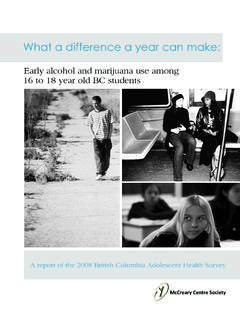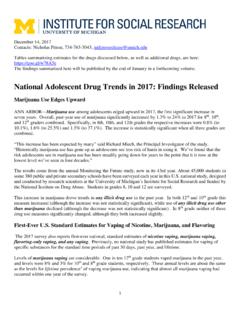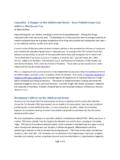Transcription of Marijuana Use Surveys: Different Methodologies May …
1 Marijuana Use Surveys: Different Methodologies May produce Different estimates February 2015. In light of policy and legal changes around Marijuana in Washington, the question How many people in this state use Marijuana ? is often asked, especially in regard to youth Marijuana use. Surveys are one tool to gather this information but their results often don't match. Why is that? Data from numerous national, regional, and state surveys are available for Washington and for comparing Washington to other states. This document lists the major surveys that provide state-level estimates , and describes the methods, population, and other characteristics of each survey. (Several of these sources can also be used to find estimates for smaller areas, such as school districts or counties.)
2 The wording of survey questions is essential to interpretation and comparison, and often differs across surveys and sometimes changes within a single survey over time. Other important factors include the age ranges included in an estimate, differential rates of non-response, and the time of year for school-based surveys. This document aims to explain why surveys that ask How many people use Marijuana ? may not come to the same result, and should be read with an understanding of the complexity in asking what might seem like a simple question. Sampling Survey methods Marijuana question wording producing estimates Source Population sampled Weighting Mode When/ Language Data quality Lifetime use 30-day use th th th Monitoring the 8 , 10 , and 12 graders in Lower 48, Accounts for Self-administered Spring of each Check for logical On how many occasions (if any) have you On how many Future (MTF); MJ public or private schools with 25+ in complex sample; also machine-readable school year inconsistencies in each used Marijuana (grass, pot) or hashish occasions (if any) have th th data available since grade (20+ for 8 ), plus continuous produce 12 grade survey conducted drug-specific triplet of Qs.
3 (hash, hash oil) in your lifetime? you used Marijuana 1976 follow-up of subsample (n=2400) of estimates adjusted usually in class period Those above a minimum (weed, pot) or hashish (national sample) seniors from each year. for absentees and by Michigan Survey number of inconsistent (hash, hash oil).. during dropouts Research Center triplets are dropped. Also the last 30 days? employee. Parents check for improbably high given advance notice reported use of multiple and options for drugs. refusal. th th th th Healthy Youth Washington 6 , 8 , 10 , and 12 State-wide sample Self-administered Fall of even Screens for dishonest or [2 pages after 30-day Q, grades 8-12 During the past 30.]
4 Survey (HYS); since graders in public schools with at least 15 accounts for machine-readable numbered school inconsistent answers; through 2012] How old were you the first days, on how many 2002 (but note students per grade. clustering of survey conducted in years tends to increase with time you Smoked Marijuana ? days did you Use wording changes) respondents within class period by grade. Screening Marijuana or hashish th (state, county, school schools; no non- teacher. Parents given English and Spanish incorporates Q about [6 grade] Have you ever, even once in (grass, hash, pot)? districts) response correction advance notice and fictitious drug and Q about your lifetime Smoked Marijuana ?
5 [In 2014, grass . options for refusal. honesty of responding, plus [In 2014, Smoked changed to Used in changed to weed ]. logical inconsistencies all Qaires]. th th Youth Risk Behavior National sample: 9 12 graders in Accounts for Self-administered Usually spring of Screens for illogical & During your life, how many times have During the past 30. Surveillance System public or private schools in 50 states + complex sample and machine-readable odd numbered implausible responses & you used Marijuana ? days, how many times (YRBSS); since 1991 DC; oversamples black & Hispanic non-response survey conducted school years patterns. did you use Marijuana ? (national sample) students usually in class period by (usually) contractor.
6 Th th Participating state samples: 9 12 Parents given advance graders in public schools; few states inc. notice and options for private schools. Washington does not refusal. participate, but Seattle Public Schools has for 2009-2013. Behavioral Risk Adult (18+), non-institutional, civilian, Accounts for CATI ~25-30 minutes Year-round data Routine call monitoring. [2009 and prior] How old were you the [immediately after Factor Surveillance telephone-owning US population, inc. complex sampling; collection; new Data collection contractor, first time you smoked Marijuana ? lifetime Q, asked if ever System (BRFSS), territories: WA started adding cell combination of sample fielded CDC, and state all perform [2012] How old were you the first time smoked/used] During state-added phones in 2008*, a dual-frame sample design weights and monthly.
7 Various data processing you smoked Marijuana , if ever? the past 30 days, on questions on Form A; (land line and cell phone) was used raking plus trimming Interviewing 7 days and quality controls. [Since 2013] How old were you the first how many days did you MJ data available nationwide in 2011; should not compare a week, day and time you used Marijuana in any form, if use Marijuana or since 2009 in WA before/after 2011. Eligibility expanded evening. ever? hashish (grass, hash, or and a few other to residents of college housing in 2012. English and Spanish [In 2013, both the smoked and used pot)? states version of the Q was asked. In 2014 and * 2008 was a pilot year only for cell 2015, only used version asked.]
8 ]. sampling; there is no weighted dual- frame dataset for 2008. National Health and Resident, civilian, non-institutionalized Weights adjust for Drug use Qs in CASI Throughout 2-year CASI system has numerous The first questions are about Marijuana [immediately after Nutrition population in 50 states + DC (inc. non- sampling, non- (with audio) portion of cycle consistency checks with and hashish. Marijuana is also called pot lifetime Q] During the Examination Survey institutional group quarters). Regular response, and physical exam, at immediate feedback to Rs, or grass. Marijuana is usually smoked, past 30 days, on how (NHANES); MJ Qs public use files only have MJ data for coverage.
9 Exam center in private English and Spanish including flagging unlikely either in cigarettes, called joints, or in a many days did you use added in 2005-2006 18+ or 20+ (varies by cycle); data for 12+ room with responses which require pipe. It is sometimes cooked in food. Marijuana or hashish? cycle available through NCHS RDC; through headphones confirmation. Hashish is a form of Marijuana that is also (national sample) age 59 for 2005-2006, 69 for 2007-2008 called 'hash.' It is usually smoked in a on. HHD screening scheduling exams pipe. Another form of hashish is hash oil. at mobile site; maximum of 15 sites in a Have you ever, even once, used given year (at least since 1999).
10 Marijuana or hashish? Continuous cycles oversample low income, black, and older residents. National Survey on Civilian, non-institutionalized pop 12+ Complex weighting In-person CAI since Yearly, throughout Qaire includes refusal The next questions are about Marijuana [2 Q after lifetime Q]. Drug Use and Health residing in 50 states + DC. Before 1991, accounts for design 1999 most Qs, inc. year conversion attempts for and hashish. Marijuana is also called pot How long has it been (NSDUH); since 1971 did not inc. AK and HI, non-institutional and non-response at drugs, answered drug Qs. CAI has extensive or grass. Marijuana is usually smoked, since you last used (but note sampling group quarters, and civilians on military multiple levels, plus directly on laptop by R English and Spanish internal consistency either in cigarettes, called joints, or in a Marijuana or hashish?)




